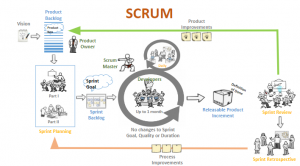Understanding Scrum: A Comprehensive Guide to the Scrum Framework and Rules
Introduction:
Scrum is a popular Agile framework that is widely used to manage and develop complex products. Scrum’s process framework helps individuals and teams to provide adaptive solutions to complex problems. Scrum is based on empirical process control, where transparency, inspection, and adaptation are the three pillars that uphold it. In this blog, we will explore the 15 components and rules of the Scrum framework, including the importance of Product Backlog Refinement (PBR).

15 Components of Scrum:
Scrum is a process framework that helps individuals and team(s) to provide adaptive solutions to complex problems. It’s the framework to develop and sustain complex Products. This framework has 15 elements or components and rules as follows:
- Roles
- Product Owner
- Scrum Master
- Developers
- Artifacts
- Product Backlog
- Sprint Backlog
- Product Increment
- Events
- Sprint
- Sprint Planning
- Daily Scrum
- Sprint Review
- Sprint Retrospective
- Commitments
- Product Goal
- Sprint Goal
- Definition of Done
- Activity
- Product Backlog Refinement
Scrum is based on Empirical process control, where there are three pillars of empiricism i.e. transparency, inspection and adaptation uphold it.
Each component of this framework serves a specific purpose and is essential to this framework’s success as follows:
- Each role serves a specific accountability.
- Artifacts provide transparency.
- Events are opportunities to Inspect & Adapt.
Importance of Product Backlog Refinement (PBR):
PBR is an activity that is defined as an act of detailing the Product Backlog Items (PBI) to prioritize and make them in a ready state where the team has all the required information about the PBI to start working on that.
This activity happens within the sprint and the Scrum team engages in an ongoing activity of breaking down the PBI into smaller, more precise items that are ready for selection in the upcoming sprint(s).
The Scrum Team performs the Product Backlog Refinement during the current sprint, if they have been unable to do so during preceding sprints to define Product Backlog items with enough precision to begin work.
The detailing of the Product Backlog Items (User Stories) typically includes writing the Acceptance Criteria as this help developers understand the functional scenarios for a requirement. One needs to be mindful that we should have detailed acceptance criteria understood and recorded in the Product Backlog Item, but at the same time we know that we are dealing with complexity and it’s not possible to predict the future, which means the requirements and it’s acceptance criteria may evolve or emerge as we start working on that, hence it’s not possible for a Product Owner to create a clear and unambiguous acceptance criteria for each Product Backlog item before it may be selected in the Sprint Backlog.
Guidelines in Scrum:
Scrum, being a framework, comes with clear boundaries, and these boundaries are the rules that one must adhere to while working with this framework.
Scrum strives to create a potentially releasable increment by the end of each Sprint. If multiple Scrum teams are working on the same product, then the combined work or integrated increment must be potentially releasable. In order for the Scrum teams to work together, there should be synchronization. However, the specific method of synchronization is left for the Scrum Team to self-manage and determine. Therefore, it is not true to say that when multiple Scrum teams are working on the same product, they must have the same sprint start date or end date. It can be a good practice, but Scrum doesn’t mandate this. There could be challenges if there is a lack of synchronization within the Sprint for the Scrum Events, but Scrum Teams self-manage to deal with those challenges. The Scrum team can use practices like Extreme Programming and DevOps to address those challenges, but Scrum doesn’t have any mandates or rules regarding how teams should synchronize their events across teams.
We have Scrum Rules, and one of the rules of Scrum states that for a product, there is only one Product Backlog and one Product Owner. There could be multiple Scrum teams working on the same product with one Product Owner, and they pull their work from the same Product backlog. Each Scrum Team working on the same product will have their independent Sprint Backlogs, and to minimize dependencies between the Scrum Teams, the Product Owner collaborates with the developers of the Scrum Teams to best analyze and break down the work.
Conclusion:
Scrum is a popular Agile framework that is widely used to manage and develop complex products. Scrum’s process framework helps individuals and teams to provide adaptive solutions to complex problems. Scrum has 15 components that are divided into 11 essentials, 3 commitments, and 1 activity. The importance of Product Backlog Refinement (PBR) and the rules that must be adhered to while working within the Scrum framework are essential for Scrum’s success. By following the rules and conducting PBR regularly, the Scrum team can ensure that they deliver high-quality products that meet the needs of their customers.

